All official European Union website addresses are in the europa.eu domain.
See all EU institutions and bodiesThis briefing provides an overview of wild pollinators, the main drivers of their decline and solutions to protect and restore them. It highlights the importance of establishing an EU-wide standardised monitoring framework of pollinators. The briefing is published in the context of the Nature Restoration Regulation, the EU Pollinators Initiative and the European Commission’s Vision for Agriculture and Food.
Key messages
Europe’s wild pollinators are essential for ecosystem resilience and food production. Around 84% of crop species in the EU depend on insect pollination.
There is strong evidence of a dramatic loss of wild pollinators, including wild bees, hoverflies, butterflies and moths; this decline puts at great risks the pollination service they provide and could severely affect nature and food security.
Protecting and restoring pollinators and their habitats needs decisive actions across different geographical and governance levels, economic sectors and society.
Pollinator-friendly management of agroecosystems and forests, conserving semi-natural habitats and reducing pesticide use, combined with targeted nature conservation and restoration, are the key solutions.
The Nature Restoration Regulation requires Member States to improve pollinator diversity and reverse their population decline. It also foresees establishing a comprehensive pollinator monitoring framework with standardised sampling methods. The framework will provide high-quality data at species level, essential for assessing progress towards the restoration target.
The importance of wild pollinators
Food security and economy
Pollinators are instrumental in crop production and contribute to healthy, diverse diets. At least EUR 5-15 billion of the EU’s annual agricultural output is directly attributed to insect pollinators. Without pollinators, food production would be severely impacted. In the EU around 84% of crop species depend, at least in part, on insect pollination (Gallai et al., 2009). These crops include oil plants (e.g. oilseed rape, sunflower or soybeans) alongside vegetables, fruits and nuts (e.g. apples, tomatoes, cucumbers, avocado, almonds or hazelnuts) which are natural sources of vitamins and other important nutrients. Insect pollinators also improve the quality of yields, for example by increasing the oil content of crops or enhancing the commercial grade of fruit (Bartomeus et al., 2014).
The European honeybee (Apis mellifera) is a domesticated, managed bee species and is most used in commercial crop production. The most important wild pollinators in Europe are wild bees, hoverflies, butterflies and moths. Some beetles, wasps and flies provide pollination service too. With increasing evidence, we now know that all these wild pollinators are the ‘unsung heroes’, who provide the bulk of pollination services: the economic value of pollination provided to crops by wild bees is on par with that provided by managed honeybees (Kleijn et al., 2015).
Pollinators are important not only for food production. Many ornamental plants as well as crops for fibre, fodder, biofuels and phytopharmaceuticals also rely on insect pollinators (van der Sluijs and Vaage, 2016). While many trees in Europe are wind-pollinated, some, like linden (genus Tilia) or hawthorn (genus Crataegus) depend on pollinators for seed and fruit production. Pollinator-dependent landscapes and natural areas contribute to recreation and cultural services, vital for our health and well-being.
Maintaining the resilience of ecosystems
Wild pollinators are part of a complex web of organisms and are key to ecosystem resilience. In Europe there are almost 2,000 bee species, 900 hoverfly species, around 480 butterfly species and as many as 10,000 moth species. All these species play a role in the functioning of ecosystems; both their diversity and abundance are crucially important. Around 78% of the wildflower species in the EU depend on insect pollination to produce seeds and fruit. For these plants to persist, pollinators are as critical as light and water. Plant communities provide shelter, shade or nesting sites for different animals. Birds and other animals feed on seeds and fruit. In turn, these animals serve as food for predators. Wildflower plants are also intrinsically linked to soil health: their roots improve soil structure, nutrient cycling, organic matter and water storage capacity; they also reduce soil erosion.
The loss and extinction of pollinators destroys the balance of this complex web; this may be the first step to the decline and extinction of other species, loss of diverse ecosystem services and, eventually, could lead to the collapse of whole ecosystems
Figure 1. Representatives of Europe’s main wild pollinator groups. From left to right: Wool Carder Bee Anthidium manicatum (©Frank Vassen), Pine Hoverfly Blera fallax (©Frank Vassen), Spanish Festoon butterfly Zerynthia rumina (©Anton Kvarnback), Wood Tiger Moth Parasemia plantaginis (©Frank Vassen).
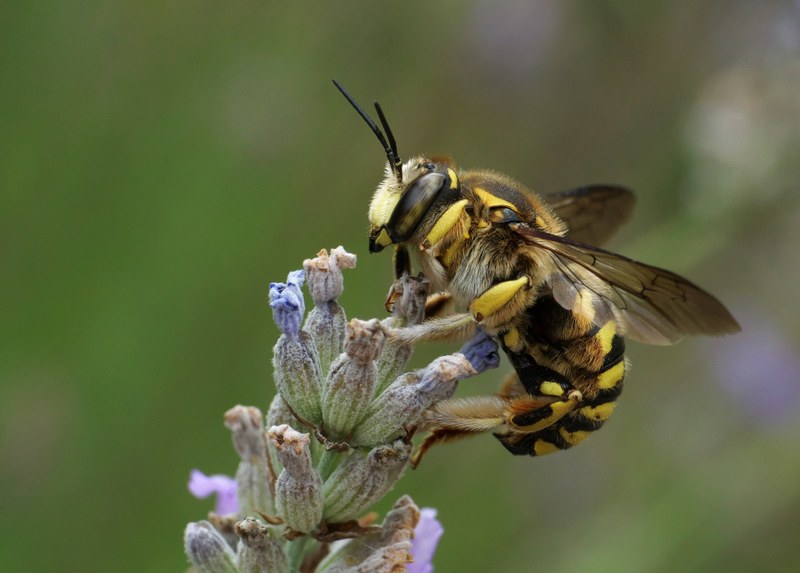
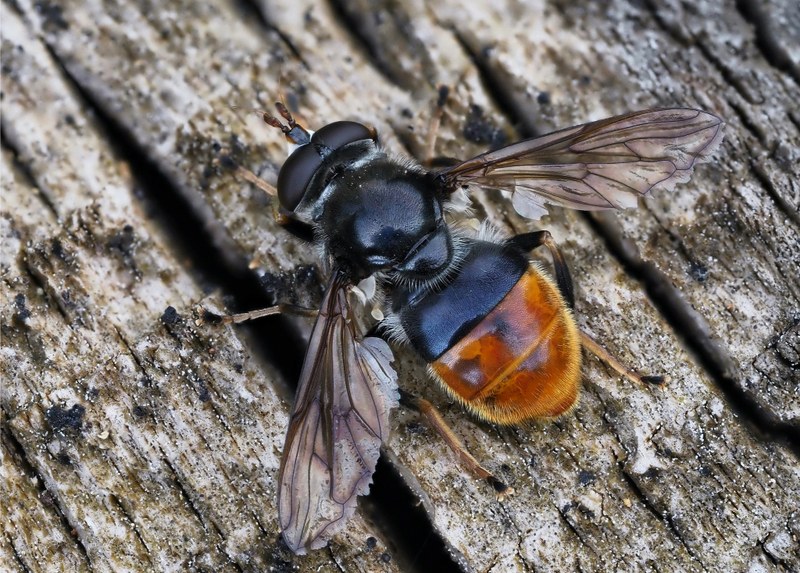
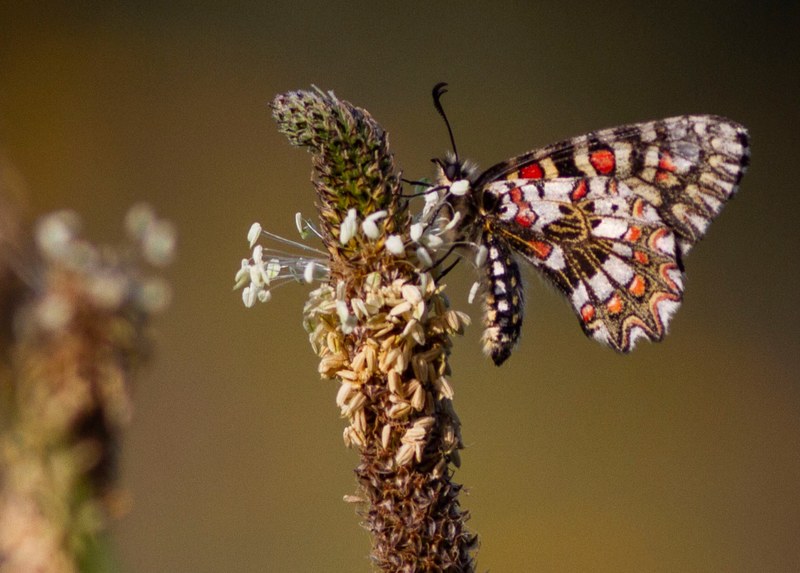

Key drivers of pollinators loss
Knowledge and scientific evidence about the dramatic decline of wild pollinators and the drivers of their loss have increased significantly in recent years (Potts et al., 2010; Vanbergen and the Insect Pollinators Initiative, 2013). Red List assessments in Europe have also shown that many species are not in a good conservation status. In the first-ever European Red List of Hoverflies, almost 40% of the hoverfly species assessed were considered threatened. Nearly 20% of assessed butterfly species were threatened or near threatened and around 9% of bees are threatened with extinction, with a further 5% of species given near threatened status. Pollinator loss is part of the wider dramatic decline of insects (Wagner, 2020), which has wide negative consequences for ecosystems and their services.
The key drivers of pollinator loss have been identified in the IPBES report on pollinators (2016) as follows:
Policy responses to pollinator loss
Growing awareness of the dramatic decline of pollinators has prompted calls from scientists and civil society for policy action in Europe.
The EU Biodiversity Strategy for 2030 and the EU Pollinators Initiative set the commitment to reverse the decline in wild pollinators by 2030.
The EU Pollinators Initiative is the key EU framework that tackles the decline of wild pollinators. First published in 2018 and revised in 2023, its priorities are to:
The Habitats Directive provides a strong legislative framework for all EU Member States to conserve the most valuable and threatened biodiversity. The directive protects semi-natural habitats, maintained through human activity, which play a crucial role in pollinator conservation and restoration. The Natura 2000 network of protected sites, established under the Habitats and Birds directives, is an important tool to ensure the favourable status of these semi-natural habitats, the development of pollinator-friendly management plans and raising awareness among wider publics.
The Nature Restoration Regulation (NRR), adopted in 2024, is the first EU-wide, comprehensive law of its kind. It aims to restore ecosystems, habitats and species across the EU’s land and sea areas to enable the long-term and sustained recovery of biodiverse and resilient nature, including pollinators.
Article 10 of the NRR requires Member States to put in place (and in a timely manner) appropriate and effective measures to improve pollinator diversity and reverse the decline of pollinator populations at the latest by 2030 — and thereafter achieve an increasing trend of pollinator populations. The NRR also stipulates the establishment of a comprehensive pollinator monitoring system which will help assess progress towards this recovery target. The Commission is expected to develop and publish a science-based method for monitoring pollinator diversity and pollinator populations in August 2025.
One of the pillars of the recently published vision for agriculture and food is future-proofing the agrifood sector by enabling it to work hand-in-hand with nature. The vision acknowledges that the ability of farmers to produce food depends on resilient ecosystems, again emphasising the critical importance of crop pollination.
Pollinator recovery initiatives at national level
Many countries in the EU and Europe have national strategies — and there are also different actions underway in many cities. Information about national initiatives is available on the EU Pollinator Hive. A few illustrative examples are provided below.
The All-Ireland Pollinator Plan is a framework established in 2015. It brings together different sectors across the island of Ireland to create a landscape where pollinators can survive and thrive. The All-Ireland Pollinator Plan website provides evidence-based guidance, support and practical tips to lots of different sectors: farmers, councils, local communities, transport authorities, businesses, schools, healthcare sites, sports clubs, gardeners and others.
The plan works on the premise that lots of small actions, taken together, can have a big impact. It emphasises knowledge exchange, both across and within sectors, for example through peer-to-peer events, sharing of success stories online and a monthly newsletter. The Plan is supported by an Irish Pollinator Research Network, made up of academics across universities on the island. The work of these researchers helps ensure the evidence-based approach of the plan.
The plan is underpinned by a national pollinator monitoring scheme, in line with EU recommendations. This is supplemented by several citizen science pollinator monitoring schemes, which also enable the public to track the impact of their actions.
All councils across the island have partnered with the plan and have agreed to take actions to make public land more pollinator friendly. An evidence-based scoring system has been developed to help farmers understand the pollinator-friendliness of their sites and what simple actions they could take to improve their score without impacting on productivity. Hundreds of local communities have embraced the plan, often by connecting businesses, schools, sports clubs and others to work together to improve their local area for nature. While pollinators remain in a precarious position, where collective actions are taken locally to create new habitat, the insects do respond very quickly.
The Norwegian government launched the National Pollinator Strategy in 2018. The overarching goal of the strategy is to ensure viable populations of wild bees and other pollinating insects in order to sustain pollination in food production and natural ecosystems. To reach this goal the strategy identifies three focus areas: increasing scientific knowledge, providing good habitats and strengthening communication on pollinators. It was followed by the Action Plan for Wild Pollinating Insects, launched in 2021, as a result of cooperation between six ministries.
Tallin’s ‘pollinator highway’ spans 13.5km through the city. The project, started in 2018, was supported by two EU projects (Augmented Urbans and B.Green) in cooperation with different stakeholder groups such as landowners, local communities and NGOs. Developing the pollinator highway has been a wide-ranging participatory process and serves as an excellent blueprint for other cities in different parts of Europe. It won an EU Green Capital award in 2023.
Main wild pollinator groups, their diversity, biology and habitats
Europe has a wide diversity of wild pollinators. The main four groups are: wild bees, including bumblebees and solitary bees, hoverflies, butterflies and moths.
Wild pollinators go through four stages of life — egg, larva, pupa and adult — which may significantly differ in length in different species groups. Different lifecycle stages have distinct ecological needs and hence rely on different habitats to fulfil those needs.
Wild bees are the most important group of pollinators. There are almost 2,000 wild bee species in Europe. Most wild bee species (around 80%) are solitary, so do not live in colonies. Females build a nest (for example in the soil, away from the ground, or in plant stems, tree trunks and even in snail shells), where they lay their eggs and then die, without ever having contact with their offspring. The larvae overwinter in the nest, then hatch when the weather becomes warmer. After the adults emerge from their nests, they live for 4-6 weeks only. Bumblebees are social; they live in burrows in the ground or nests above the ground, in colonies of 50-400 individuals (for comparison, on average there are up to 40,000 individuals in a hive of the domesticated honeybee). The queen bumblebee starts to build her nest in spring, where she raises her eggs which hatch in summer into worker bees and male bees. In autumn, bumblebee nests die off and only new queen bees survive, going into hibernation during winter. The following spring, new queen bees emerge and the lifecycle starts again.
Figure 2. Wild bees. From left to right: Grey-patched Mining Bee Andrena nitida (©Frank Vassen), Violet Carpenter Bee Xylocopa violacea (©Anton Kvarnback), Common Carder Bee Bombus pascuorum (©Frank Vassen), Buff-tailed Bumblebee Bombus terrestris (©Anton Kvarnback).

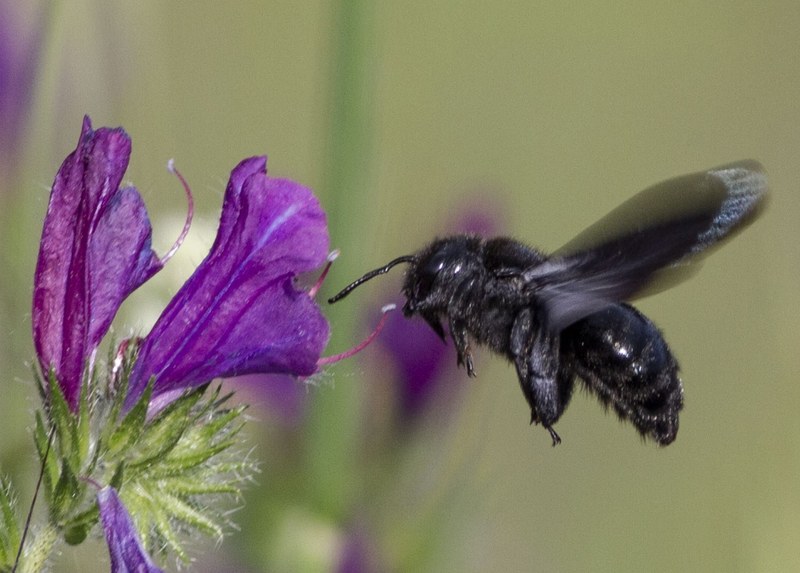


Hoverflies are the second most important pollinator group. There are almost 900 hoverfly species in Europe. The adults are very diverse in their appearance; many species mimic the looks of wasps or bees to protect themselves from predators. Some larvae can live in stagnant water but most live in terrestrial habitats. The diet is very diverse: some species feed on deadwood, plants or fungi. Others provide pest control ecosystem service, as they feed on aphid pests, which are one of the most destructive crop pests in temperate regions (Pekas et al, 2020). Adult hoverflies feed on pollen and nectar and live for about four weeks, during which females lay about 400 eggs and their lifecycle continues.
Figure 3. Hoverflies. From left to right: Logjammer Hoverfly Chalcosyrphus eunotus (©Frank Vassen), Crimson-belted Hoverfly Brachypalpoides lentus (©Frank Vassen), Green Forest Hoverfly Caliprobola speciosa (©Frank Vassen), Bumblebee Mimic Hoverfly Volucella bombylans (©Frank Vassen).


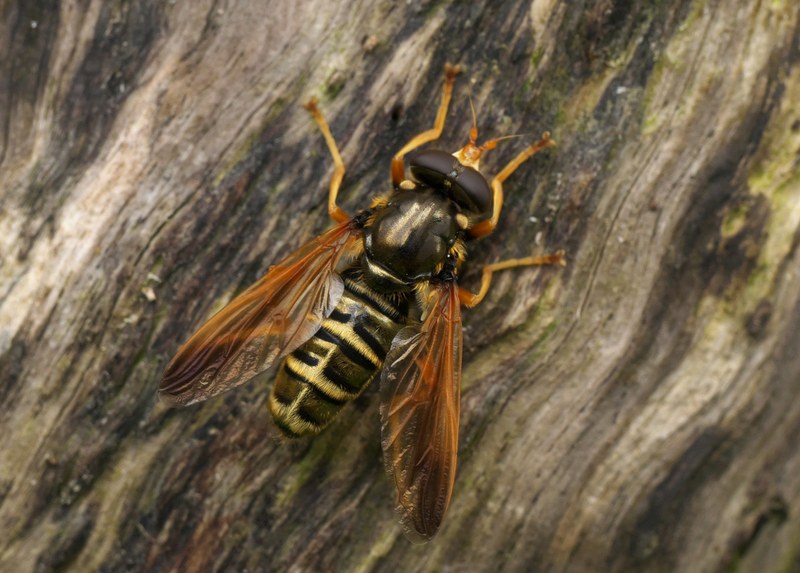
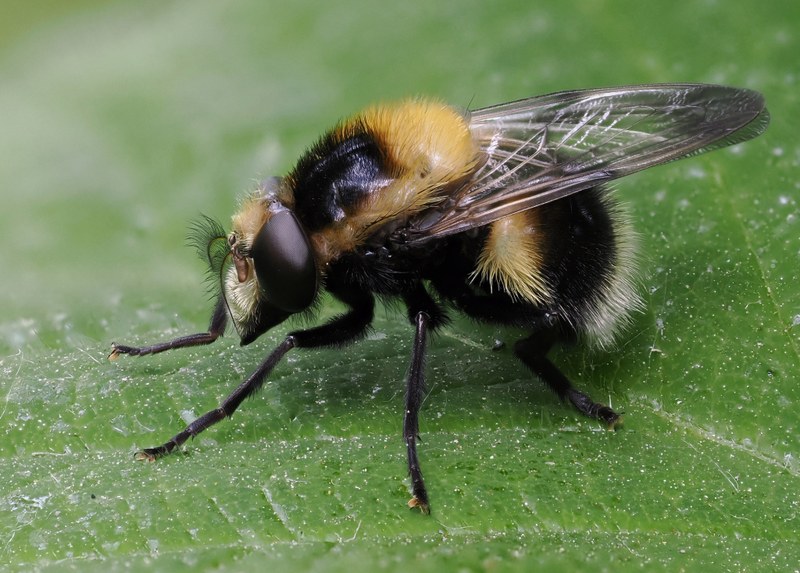
Butterflies are the most easily recognisable group. There are 482 species in Europe; nearly one third (30%) of these are endemic, i.e. found only in Europe. Butterfly larvae (caterpillars) can have very specific dietary requirements: as many as 20% of European butterfly larvae are monophagous, feeding on only one species of plant; half are oligophagous, as they feed on a just few different but closely related plants; 30% are polyphagous and feed on plants in many different families. When adult butterflies forage on plants for nectar, they also collect pollen on their body, then transfer it to other plants, hence providing the pollination service.
Figure 4. Butterflies. From left to right: Purple-edged Copper Lycaena hippothoe (©Frank Vassen), Green Hairstreak Callophrys rubi (©Frank Vassen), Swallowtail Papilio machaon (©Anton Kvarnback), caterpillar of Swallowtail Papilio machaon (©Frank Vassen).
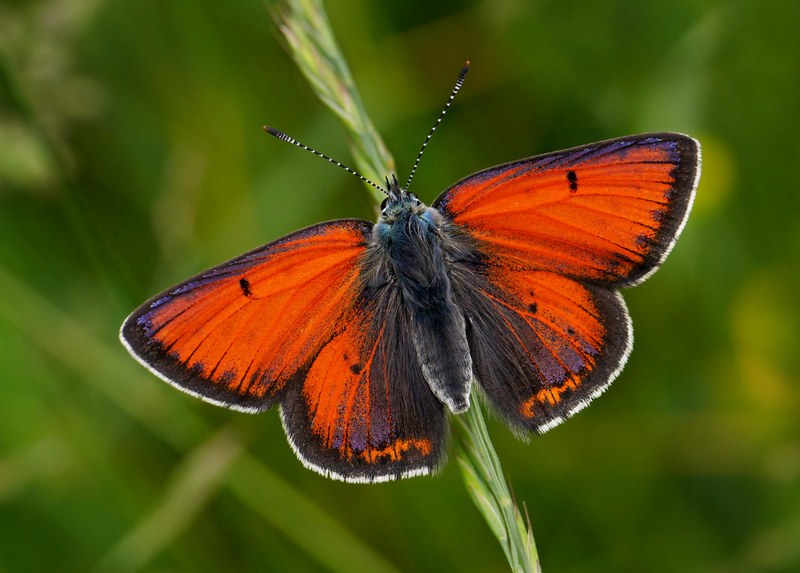
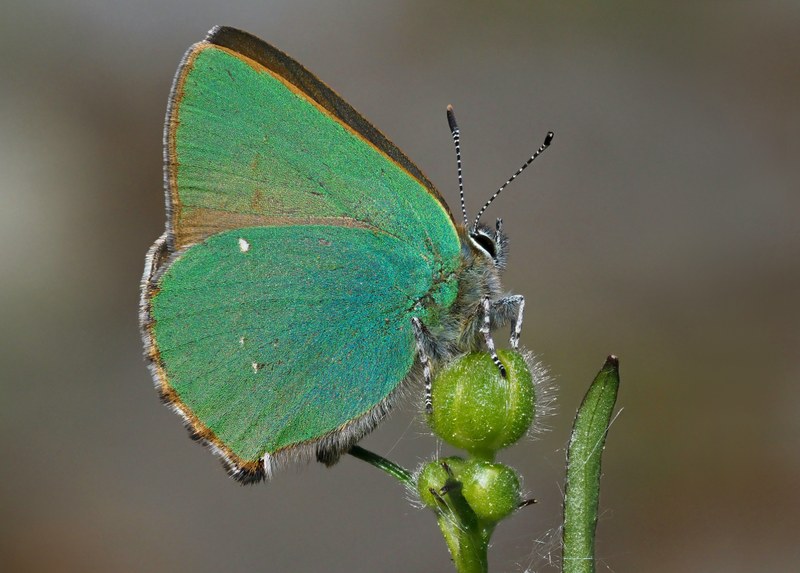
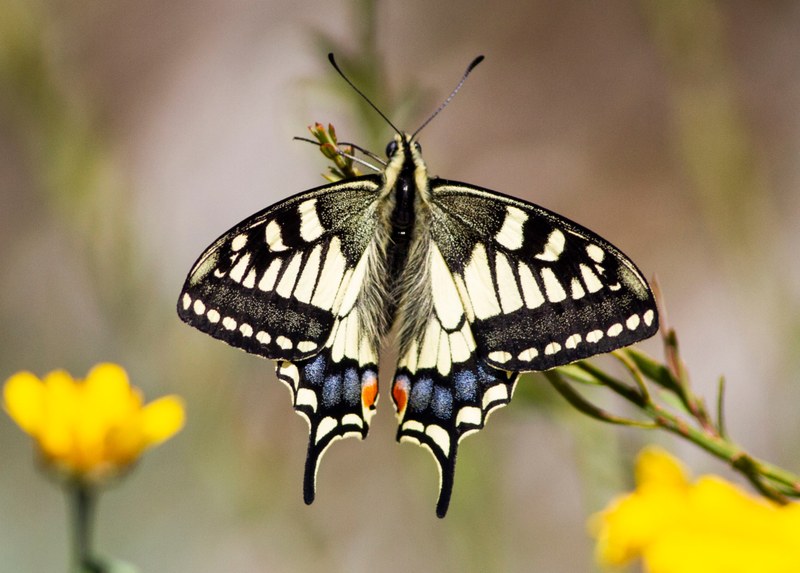
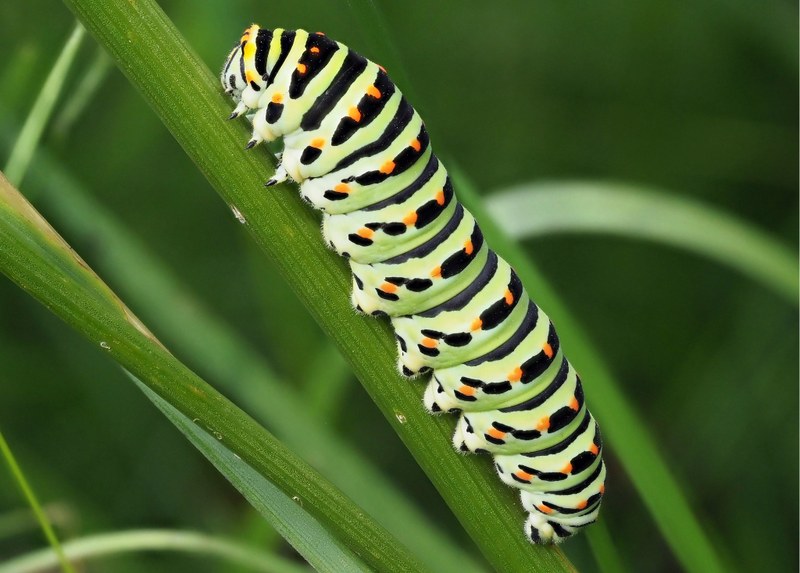
There are approximately 10,000 species of moths in Europe (Red List assessment is forthcoming). Most species are nocturnal, but some can be active both at night and during the day. Their feeding habitats are like those of butterflies, although some adults do not feed at all and live for a few days only, to mate and lay eggs. Butterflies and moths are a very important food source for other animals (birds, small mammals, bats, other insects) in different stages of their development; the declining numbers of butterflies and moths may in turn have negative effects on those animals that feed on them.
Figure 5. Moths. From left to right: Mint Moth Pyrasta aurata (©Frank Vassen), Copper Underwing Amphipyra pyramidea (©Frank Vassen), Small Elephant Hawk-moth Deilephila porcellus (©Frank Vassen), Six-spot Burnet Zygaena filipendula (©Frank Vassen).
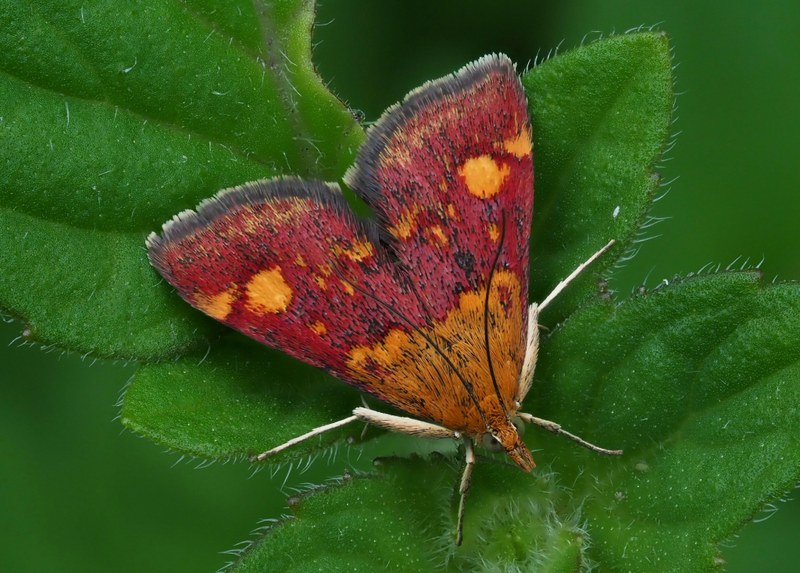
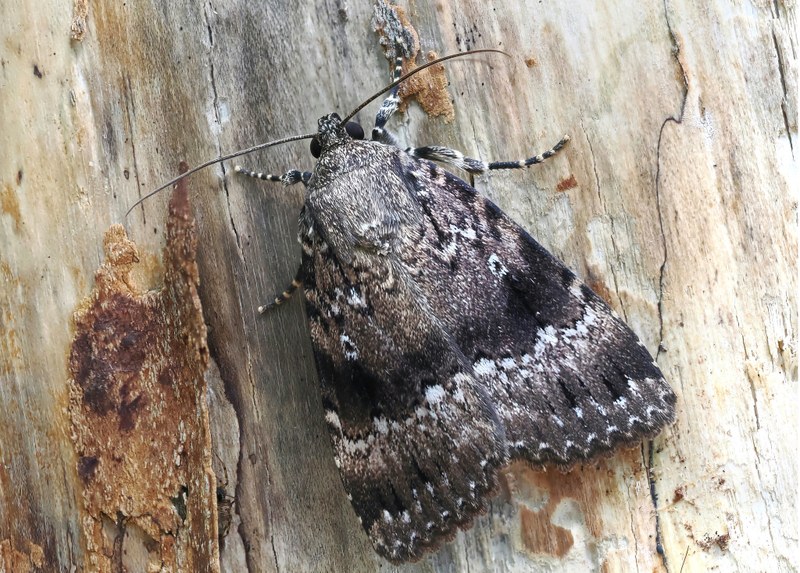


Habitats of wild pollinators and pollinator-friendly management:
Agroecosystems
The following semi-natural habitats are vital for all pollinator groups:
- Extensive, semi-natural grasslands: thanks to their high flower richness, they are an essential source of nectar and pollen throughout the season. Many pollinators may nest in stems of different plants or lay their eggs on leaves. Yet semi-natural grasslands are very often threatened by intensification or abandonment, when mowing for hay or extensive grazing are stopped (Öckinger and Smith, 2006; Johanssen et al., 2019; Larkin and Stanley, 2021).
- Heathlands and scrub: these habitats are rich in resources for feeding and nesting, in particular for bumblebees and solitary bees. Importantly, heath and scrub require regular extensive grazing to maintain the appropriate habitat structure (i.e. with low growing plants and open areas) and to prevent succession to closed woodland (Keenleyside and Underwood, 2020).
These landscape elements also support pollinator populations:
- Wildflower strips: natural or sown with native plants and typically located at field margins, these features have been shown to benefit pollinators (Grass et al., 2016; Ouvrard P. et al., 2018).
- Hedgerows: in addition to providing food resources and nesting sites, hedgerows act as corridors in the landscape, linking different habitats (Garratt et al., 2017).
- Forest/woodland patches: these small features provide forage; ponds and ditches serve as hoverfly larval resources (Senapathi et al., 2017).
- Mass flowering crops: fields of, for instance, legumes or oilseed rape, can be an important food resource, in particular early in the season, or when there is a lack of wild flowering plants in an area (Westphal et al., 2003; Toikkanen et al, 2022). Orchards, especially with reduced mowing of the grass and with wild flowering undergrowth, are a particularly valuable habitat for pollinators (Pardo and Borges, 2020).
Soil
Around 70% of wild bees nest below ground and require protection during this long and crucial period of their lifecycle, which may last a year. Deep soil tillage and pesticides cause loss of bee abundance and diversity (Christmann S., 2022; Tschantz et al., 2024). Nesting in soil is directly beneficial for soil structure and recent research shows that the role of ground-nesting bees as soil ecosystem engineers deserves greater attention (Tschantz et al., 2025). However, climate change, in particular droughts, may affect not only flowering plants, but also soil conditions, disrupting bees’ lifecycle.
Forests
Forests provide flowers, nesting and overwintering sites for pollinators. Forest edges, forest pastures, meadows and other open spaces are particularly important (Ulyshen et al. 2023). Larvae of many hoverflies live on standing or lying deadwood, which occurs in sustainably managed forests but not industrialised monocultures. Some bee species use old, veteran trees as their nests (Proesmans et al., 2019).
Freshwater habitats
Many hoverfly species in their larval stages live underwater, on shores and in ditches (Stewart et al., 2017).
Urban areas
Cities can act as important refuges for pollinators (Hall et al., 2017). Well prepared interventions, targeted to local conditions and using native plants, provide a range of habitats (Buchholz et al., 2020; Persson A., 2020; see also Box 1).
Management solutions to protect and restore pollinators
In agroecosystems, pollinator abundance and diversity benefit from high-quality habitats (described above), especially in and around farms. Healthy populations do not depend purely on single habitats, but also their diversity: the presence and connectivity of different semi-natural habitats, landscape elements and crop types is extremely important. This situation is typically found in more sustainable and extensive agricultural systems that are based on low-input farming practices and are also much less likely to apply pesticides and other agrochemicals, which are particularly detrimental to wild pollinators.
Figure 6. The farmland pollinator scoreboard.
Please select a resource that has a preview image available.
Planning for pollinators should also consider temporal aspects, for example stabilising the availability of food resources throughout the season. Avoiding early cutting of grasslands, maintaining uncut hedges and planting targeted legume mixtures can greatly support wild pollinators. Sustainable, biodiversity-friendly forest management provides similar benefits.
Many of the important habitats for pollinators highlighted earlier are listed in Annex I of the Habitats Directive i.e. different types of semi-natural grassland, heath, scrub, forest and freshwater habitats. However, according to the most recent State of Nature in the EU report, these habitats are not in a good conservation status. Recently developed action plans for two of the most threatened habitats of the Habitats Directive, namely European dry heaths (4030) and semi-natural calcareous grasslands and scrubland (6210), recognise their high importance for wild pollinators. The plans provide guidance on their management, such as extensive mowing or grazing.
Natura 2000 sites and other nationally designated protected areas, can also significantly aid pollinator conservation and recovery. However, the strategic management plans for Natura 2000 sites currently do not have specific requirements for pollinators. Pollinator-friendly, well-designed and targeted conservation plans that are co-developed between a range of different stakeholders would strongly reinforce current, less streamlined conservation efforts.
Common agriculture policy (CAP) objectives provide opportunities to support pollinators, through eco-schemes and other environmental measures building on the practices required under conditionality. While the current CAP Strategic Plans (2023-2027) in EU Member States focus on such support to different extents, there are common actions that aim to reduce the use of pesticides and promote organic production, the presence of landscape features and conservation or restoration of biodiversity on agricultural land. Some Member States have developed eco-schemes specifically for pollinators. Italy’s Eco-schema 5 includes specific measures for pollinators while Poland has Ekoschemat II which covers areas with melliferous plants.
EU pollinator monitoring framework: rationale and benefits
Despite increased knowledge of pollinators and their ecological requirements, there are still major knowledge gaps. We lack comprehensive information about the status and trends of different species alongside insights on the drivers of their decline (Breeze et al., 2021). There are several valuable monitoring initiatives in countries or regions, but they differ in which taxa they cover, or the methods they employ. Although the European Butterfly Monitoring Scheme is the longest running information source about species abundance, its geographical coverage and the number of species monitored are still limited.
To address these knowledge gaps, in June 2019 the Commission launched the STING (Science and Technology for Pollinating Insects) project through which it mandated a group of experts to develop options for a field-based monitoring scheme that would provide robust information on the status and trends of pollinator populations in EU Member States. The proposed EU Pollinator Monitoring Scheme (EU-PoMS) was finalised and published in October 2020.
Between 2021 and 2023, the Commission piloted and tested the proposed scheme on the ground through the SPRING (Strengthening Pollinator Recovery through Indicators and Monitoring) project. The project strengthened taxonomic monitoring capacity for pollinating insects and supported preparation for the implementation of EUPOMS.
Learning from the SPRING pilot, the STING 2 technical expert group comprising 26 international experts from 12 countries, undertook a thorough review and analysis, leading to a refined proposal for an EU Pollinator Monitoring Scheme, published in October 2024.
Monitoring under Nature Restoration Regulation
The Nature Restoration Regulation (NRR) requires Member States to develop national restoration plans that detail how they will deliver on targets. The NRR also requires Member States to monitor and report on their progress.
To monitor progress on reversing pollinator decline, species level information is required. Without this information at species level, it is not possible to properly assess the complexity, richness and ecological value of the pollinator community, which is essential to maintain the resilience of ecosystems and ensure pollination of crops for food security.
The proposed pollinator monitoring framework developed under the NRR will use standardised monitoring methods to ensure robust and comparable data. The design of sampling methods supports the recording of abundance and diversity at the species level, using transects for wild bees, hoverflies and butterflies, and light traps for moths.
This monitoring framework will be a breakthrough information source about pollinator species and about progress in reversing their decline. Acknowledging the role of different pollinators in the functioning of ecosystems and maintaining their resilience, the framework will monitor species that are more common as well as rare and threatened species. Those rare species typically occur in specific, limited locations or they are highly specialised, hence difficult to sample by the general monitoring scheme. The framework therefore will include a specific module intended to monitor rare and threatened species.
Benefits
There are multiple benefits stemming from the introduction of an EU-wide pollinator monitoring framework. The standardised approach makes it possible to optimise the cost-effectiveness of setting up and deploying monitoring schemes in Member States and planning the human and technical resources needed.
Data aggregation will contribute to building a baseline of status and trends of pollinator species diversity and abundance, as well as the calculation of indicators that fulfil NRR Article 10 requirements. Insights and knowledge generated from their analysis will help identify policy and management responses to drivers of pollinator loss at different geographical and governance levels.
Moreover, the emerging knowledge will strongly benefit research, shaping understanding of pollinator biology and ecology, plant–pollinator networks and developing strategies to optimise pollinator-friendly management. It could also help to identify and/or predict challenges and opportunities which may arise in the next years and decades, as well as inform preventive action.
Pollinator monitoring can offer employment opportunities, including professional surveyors who will sample transects and light traps and identify species. The current lack of taxonomic capacity (European Red List of Insect Taxonomists) is being addressed through capacity building; training courses are underway thanks to efforts under the EU Pollinators Initiative. Still, strengthening university curricula and ensuring sustainable employment opportunities for taxonomists is essential.
Finally, citizen scientists will support pollinator monitoring, i.e. volunteers collecting data. This will help to engage society-at-large in tackling pollinator decline and raise wider awareness and knowledge of pollinators and the importance of biodiversity in our everyday life.
Identifiers for EEA Briefing 06/2025
Title: Protecting and restoring Europe’s wild pollinators and their habitats
HTML: TH-01-25-015-EN-Q - ISBN: 978-92-9480-720-5 - ISSN: 2467-3196 - doi: 10.2800/6525185
Baldock, K., 2020, ‘Opportunities and threats for pollinator conservation in global towns and cities’, Current Opinion in Insect Science 38, pp. 63-71 (DOI: 10.1016/j.cois.2020.01.006).
Balfour, N. J. and Ratnieks, F. L., 2022, ‘The disproportionate value of ‘weeds’ to pollinators and biodiversity’, Journal of Applied Ecology 59, pp. 1209–1218 (DOI: 10.1111/1365-2664.14132).
Bartomeus, I., et al., 2014, ‘Contribution of insect pollinators to crop yield and quality varies with agricultural intensification’, PeerJ 2:e328 (DOI: 10.7717/peerj.328).
Breeze, T.D., et al., 2021, ‘Pollinator monitoring more than pays for itself’, J. Appl. Ecol. 58, pp. 44-57 (DOI: 10.1111/1365-2664.13755).
Buchholz, S., et al., 2020, ‘Wild bees in urban grasslands: Urbanisation, functional diversity and species traits’, Landscape and Urban Planning 196, 103731 (DOI: 10.1016/j.landurbplan.2019.103731).
Christmann, S., 2022, ‘Regard and protect ground-nesting pollinators as part of soil biodiversity’, Ecological applications 32(3), e2564 (DOI: 10.1002/eap.2564).\
Descamps, C., et al., 2021, ‘The effects of drought on plant–pollinator interactions: What to expect?’, Environmental and Experimental Botany 182, 104297 (DOI: 10.1016/j.envexpbot.2020.104297).
Freimuth, J., et al., 2022, ‘Climate warming changes synchrony of plants and pollinators’, Proc. R. Soc. B. 289, 20212142 (DOI: 10.1098/rspb.2021.2142).
Frigero, M.L.P., et al., 2025, ‘Extreme events induced by climate change alter nectar offer to pollinators in cross pollination-dependent crops’, Sci Rep 15, 10852 (DOI: 10.1038/s41598-025-94565-2).
Garratt, M., et al., 2017, ‘The benefits of hedgerows for pollinators and natural enemies depends on hedge quality and landscape context’, Agriculture, Ecosystems & Environment 247, pp. 363-370 (DOI: 10.1016/j.agee.2017.06.048).
Grass, I., et al., 2016, ‘Much more than bees—Wildflower plantings support highly diverse flower-visitor communities from complex to structurally simple agricultural landscapes’, Agriculture, Ecosystems & Environment 225, pp. 45-53 (DOI: 10.1016/j.agee.2016.04.001).
Halada, L., et al., 2011, ‘Which habitats of European importance depend on agricultural practices?’, Biodivers. Conserv. 20, pp. 2365-2378 (DOI: 10.1007/s10531-011-9989-z).
Hall, D., et al., 2017, ‘The city as a refuge for insect pollinators’, Conservation Biology 31, pp. 24-29 (DOI: 10.1111/cobi.12840).
IPBES (2016). ‘The assessment report of the Intergovernmental Science-Policy Platform on Biodiversity and Ecosystem Services on pollinators, pollination and food production’, S.G. Potts, V. L. Imperatriz-Fonseca, and H. T. Ngo, (eds). Secretariat of the Intergovernmental Science-Policy Platform on Biodiversity and Ecosystem Services, Bonn, Germany. 552 pages.'
Johanssen, L., et al., 2019, ‘Traditional semi-natural grassland management with heterogeneous mowing times enhances flower resources for pollinators in agricultural landscapes’, Global Ecology and Conservation 18, e00619 (DOI: 10.1016/j.gecco.2019.e00619).
Kleijn, D., et al., 2015, ‘Delivery of crop pollination services is an insufficient argument for wild pollinator conservation’, Nature Communications 6, 7414 (DOI: 10.1038/ncomms8414).
Klein, A-M., et al., 2007, ‘Importance of pollinators in changing landscapes for world crops’ Proc. R. Soc. B. 274, pp. 303–313 (DOI: 10.1098/rspb.2006.3721).
Larkin, M. and Stanley, D., 2021, ‘Impacts of management at a local and landscape scale on pollinators in semi-natural grasslands’, Journal of Applied Ecology 58, pp. 2505-2514 (DOI: 10.1111/1365-2664.13990).
Lucas, A., et al., 2013, ‘Wild Pollinators Enhance Fruit Set of Crops Regardless of Honey Bee Abundance’, Science 339, pp. 1608-1611 (DOI: 10.1126/science.1230200).
Martínez-Núñez, C., et al., 2022, ‘Temporal and spatial heterogeneity of semi-natural habitat, but not crop diversity, is correlated with landscape pollinator richness’, Journal of Applied Ecology 59, pp. 1258-1267 (DOI: 10.1111/1365-2664.14137).
Maurer, C., et al., 2022, ‘Different types of semi-natural habitat are required to sustain diverse wild bee communities across agricultural landscapes’, Journal of Applied Ecology 59, pp. 2604-2615 (DOI: 10.1111/1365-2664.14260).
Memmott, J., et al., 2007, ‘Global warming and the disruption of plant–pollinator interactions’, Ecology Letters 10, pp. 710-717 (DOI: 10.1111/j.1461-0248.2007.01061.x).
Öckinger, E. and Smith, H., 2007, ‘Grasslands as population sources for pollinating insects in agricultural landscapes’, Journal of Applied Ecology 44, pp. 50-59 (DOI: 10.1111/j.1365-2664.2006.01250.x).
Ouvrard, P., et al., 2018, ‘Flower‑strip agri‑environment schemes provide diverse and valuable summer flower resources for pollinating insects’, Biodiversity Conservation 27, pp. 2193-2216 (DOI: 10.1007/s10531-018-1531-0).
Pardo, A. and Borges, P., 2020, ‘Worldwide importance of insect pollination in apple orchards: A review’, Agriculture, Ecosystems & Environment 293, 106839 (DOI: 10.1016/j.agee.2020.106839).
Pedersen, S., et al., 2025, ‘Broad ecological threats of an invasive hornet revealed through a deep sequencing approach’, Science of the Total Environment 970, 178978 (DOI: 10.1016/j.scitotenv.2025.178978).
Pekas, A., et al, 2020, ‘One stone; two birds: concurrent pest control and pollination services provided by aphidophagous hoverflies’, Biological Control 149, 104328 (DOI: 10.1016/j.biocontrol.2020.104328).
Persson, A., et al., 2020, ‘Wild bees and hoverflies respond differently to urbanisation, human population density and urban form’, Landscape and Urban Planning 204, 103901 (DOI: 10.1016/j.landurbplan.2020.103901).
Potts, S., et al., 2010, ‘Global pollinator declines: trends, impacts and drivers’, Trends in Ecology and Evolution 25(6), pp. 345-353 (DOI: 10.1016/j.tree.2010.01.007).
Proesmans, W., et al., 2019, ‘Importance of forest fragments as pollinator habitat varies with season and guild’, Basic and Applied Ecology 34, pp. 95-107 (DOI: 10.1016/j.baae.2018.08.004).
Rivers-Moore, J., et al., 2020, ‘Wooded Semi-Natural Habitats Complement Permanent Grasslands in Supporting Wild Bee Diversity in Agricultural Landscapes’, Insects 11(11), 812 (DOI: 10.3390/insects11110812).
Senapathi, D., et al., 2017, ‘Landscape impacts on pollinator communities in temperate systems: evidence and knowledge gaps’, Functional Ecology 31, pp. 26-37 (DOI: 10.1111/1365-2435.12809).
Settele, J., et al., 2016, ‘Climate change impacts on pollination’, Nature Plants 2, 16092 (DOI: 10.1038/nplants.2016.92).
Stewart, R., et al., 2017, ‘Ecosystem services across the aquatic–terrestrial boundary: Linking ponds to pollination’, Basic and Applied Ecology 18, pp. 13-20 (DOI: 10.1016/j.baae.2016.09.006).
Sponsler, D.B., et al., 2019, ‘Pesticides and pollinators: A socioecological synthesis’, Science of The Total Environment 662, pp. 1012-1027 (DOI: 10.1016/j.scitotenv.2019.01.016)
Tälle, M., et al., 2016, ‘Grazing vs. mowing: A meta-analysis of biodiversity benefits for grassland management’, Agriculture, Ecosystems & Environment 222, pp. 200-212 (DOI: 10.1016/j.agee.2016.02.008).
Toikkanen, J., et al., 2022, ‘Effects of landscape composition on hoverflies (Diptera: Syrphidae) in mass‑flowering crop fields within forest‑dominated landscapes’, Journal of Insect Conservation 26, pp. 907-918 (DOI: 10.1007/s10841-022-00436-w).
Tschantz, P., et al., 2024, ‘A review of soil tillage impacts on ground-nesting wild bees – mechanisms, implications and future research perspectives’, Agriculture, Ecosystems & Environment 375, 109224 (DOI: 10.1016/j.agee.2024.109224).
Tschantz, P., et al., 2025, ‘Beyond pollination – The neglected contribution of ground-nesting bees to soil functions’, Basic and Applied Ecology 84, pp. 92-100 (DOI: 10.1016/j.baae.2025.02.003).
Ulyshen, M., et al., 2023, ‘Forests are critically important to global pollinator diversity and enhance pollination in adjacent crops’, Biological Reviews 98, pp. 1118-1141 (DOI: 10.1111/brv.12947).
Vanbergen, A.J. and the Insect Pollinators Initiative, 2013, ‘Threats to an ecosystem service: pressures on pollinators’, Frontiers in Ecology and the Environment, 11: 251-259 (DOI: 10.1890/120126).
van der Sluijs, J. P. and Vaage, N.S., 2016, ‘Pollinators and Global Food Security: the Need for Holistic Global Stewardship’, Food ethics 1, pp. 75–91 (DOI: 10.1007/s41055-016-0003-z).
Wagner, D.L., 2020, ‘Insect Declines in the Anthropocene’, Annual Review of Entomology 65, pp. 457-480 (DOI: 10.1146/annurev-ento-011019-025151).
Wenzel, A., et al., 2020, ‘How urbanization is driving pollinator diversity and pollination – A systematic review’, Biological Conservation 241, 108321 (DOI: 10.1016/j.biocon.2019.108321).
Westphal, C., et al., 2003, ‘Mass flowering crops enhance pollinator densities at a landscape scale’, Ecology Letters 6, pp. 961-965 (DOI: 10.1046/j.1461-0248.2003.00523.x).
